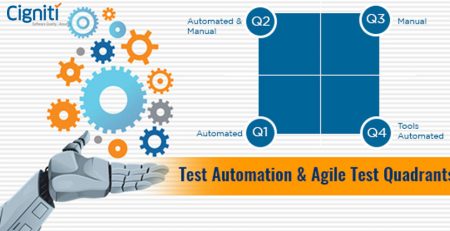7 Ways to Make Test Automation Effective in Agile Development
|
Listen on the go!
|
While automating the testing process, there is a certain amount of collaborative effort required from everyone in the agile team. This is an important prerequisite to successful automation of the testing process. QA engineers need to keep a track on any task that has a repetition of more than two times within a short period of time. These tasks would all need to be automated, preferably with a well-known tool or open source code. The development of functional test automation is generally done by software developers in test, as they would be able to easily monitor the feature development.
Repetitive processes within a short span of time would often need to be quickly automated. However, owing to the amount of time involved in the automation process, it is still important to determine what tests precisely should be automated in the agile environment. Although the product owners may be able to immediately suggest points to automate, it also depends on developers working on the detailed code. Ultimately, the QA engineers would also be looking at opportunities that call for ad-hoc automation or on-the-fly automation, in order to increase the test coverage.
Test automation undoubtedly provides assistance during the application lifecycle. However, there are numerous challenges associated with test automation, if the process is not well thought-out beforehand. In this blog post, we examine seven processes that depict a clear picture of how to make test automation effective in agile development.
- The Inception of Automation:
- Automated test scripts are created in a similar fashion to software code design. The software code being designed and tested involves a fair number of features. This requires a fair amount of coding and subsequent testing for the software to function robustly. It is best to develop the automated test scripts incrementally, just like the actual software application. It is essential to understand that a single test automation framework cannot be a reality, as too many elements factor into it.
- The return on investment (ROI) is a crucial factor that plays in developing the automated test cases. When ROI is not guaranteed, a bare minimum solution could begin the process. When the tests are slowly built, team members realize that they are working well and yielding results, especially by saving time and effort, there is scope to invest more and take automation more seriously.
- Selective Automation:
- Immaterial of how many features a said framework may have, if the tests that are a part of its solution are not relevant, the entire effort is wasted. Ultimately, the framework cannot supersede the code. Although the idea of a state-of-the-art framework is extremely appealing, such obsession would ultimately defeat the purpose of timely effectiveness.
- In addition, automating tests for just the sake of automation is a complete waste of time, effort, and resource utilization. The amount of maintenance and the execution time are important factors that need to be considered prior to automation. All automated tests become an integral part of the software lifecycle and must be maintained an executed accordingly. Tests that are overly complex slowdown the feedback cycle and best be avoided.
- Optimum Timing:
- In the agile environment, there are a number of iterations and there are continuous sets of sprints. Quality is a genuine concern under such circumstances, as several sprints finish in time but not with quality. These sprint backlogs make it difficult to devote time for the development, debugging and testing of each iteration.
- Due to these factors, it becomes crucial for the team to allocate appropriate time specifically for testing. Often, it is advisable for test automation to run in parallel to the software development stage, as this approach mitigates any foreseeable lags. This gives more scope to the QA engineers to develop efficient tests through exploratory search.
- Client Test Coverage:
- Hypothetically speaking, having tools such as a DB dumper script can help paint a picture as to the amount of testing that is done for an application performing the basic function of sending emails. Such coverage analysis tools help QA engineers save time and effort through automatic reporting. In addition, these tools ensure that features required for testing are not left unattended.
- The ideas that consequently build, as further brainstorming is done, can lead to breakthroughs that change the testing pattern altogether. It is important to think broadly when it comes to test automation, rather than merely on test cases.
- Regression Testing Automation:
- Regression testing is absolutely necessary to guarantee the functionality of the system. When quality test scripts are developed keeping in mind the concept of regression testing, it provides a great help in maintaining and monitoring the performance of the test scripts.
- Regression testing can then be run smoothly and without manual intervention. When the test scripts are developed with the concept of regression testing, the team would then be able to complete testing without numerous changes in the scripts.
- All-round Visibility:
- Ensuring that the automation and associated processes are relatively simple and accessible, and making sure that the results of test automation are visible to all the stakeholders, is vital. Showcasing the trends, the statistics, and the overall code quality improvement can make all the difference when it comes to implementing more automation.
- Making such data visible allows resources to form a positive perspective on their own. This makes it simpler to update test scripts periodically, and guarantees collaborative effort through mutual cooperation.
- Keep an eye out for the Developers:
- It is essential to keep an eye out for the developers and the general development environment. From machines to cloud simulations, software development comprises of a complete network right form the back-end system architecture to the front-end interactions, along with external applications.
- Bugs that are detected could be triggered due to any form of disconnection between the networks, configurations, or the like. It is essential to understand the functionality of the actual environment, in order to successfully perform root-cause analysis that yields in constructive solutions.
Conclusion
Cigniti Technologies understands that test automation helps accelerate regression test efforts in a cost effective manner, and allows constantly unattended execution. Cigniti’s test automation framework (CTAF) is a tool agnostic testing solution for validating complex business processes. CTAF uses a keyword driven approach to help non-technical users validate business processes. CTAF has delivered 30% improvement in productivity and 40% reduction in test maintenance efforts in numerous test automation engagements.




Leave a Reply